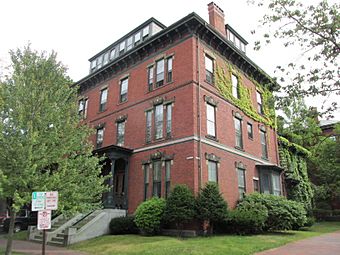Thomas Brackett Reed House facts for kids
|
Thomas B. Reed House
|
|

Thomas B. Reed House
|
|
| Location | Portland, Maine |
|---|---|
| Area | less than one acre |
| Built | 1876 |
| Architect | Fassett, F.H., & Son; Libby, Simon H. |
| Architectural style | Late Victorian |
| NRHP reference No. | 73000239 |
Quick facts for kids Significant dates |
|
| Added to NRHP | May 7, 1973 |
| Designated NHL | May 15, 1975 |
The Thomas Brackett Reed House is an old brick house in Portland, Maine. It was built in 1876. This house is a National Historic Landmark. It got this special title in 1975.
The house is important because of Thomas Brackett Reed (1839–1902). He was a powerful leader in the United States government. Reed was the Speaker of the House of Representatives. He held this job from 1889 to 1891 and again from 1895 to 1899. He lived at number 32 Deering Street from 1888 until he passed away in 1902.
Thomas B. Reed made the Speaker's job much stronger. He created a set of rules called the Reed Rules. These rules are still used today to help guide debates in the House.
Contents
Exploring the Thomas B. Reed House
The Reed House stands on a corner in Portland's West End. It is a tall brick building with three and a half stories. The front of the house faces Deering Street. It has a balanced design with matching entrances.
On each side of the entrances are triple windows. These windows have one tall, wide window with two smaller ones next to it. This style is repeated on the upper floors. The windows have fancy stone and brick designs around them. Detailed brickwork separates each floor. The main part of the house has a sloped roof. A wide dormer window was added to the roof later. There have been some small changes to the back of the house over time.
Who Designed and Lived Here?
The house was designed by F. H. Fassett & Son. It was built in 1876. Many other stylish homes from that time are nearby. Thomas Brackett Reed bought number 32 in 1888. It was his home until he died in 1902.
At the same time, number 30 was owned by William L. Putnam. He was a lawyer and a former mayor of Portland. Putnam became a federal judge in 1891.
Thomas B. Reed's Impact on Congress
Thomas Brackett Reed made big changes to how the United States House of Representatives worked. He was the Speaker from 1889 to 1891 and 1895 to 1899. Before Reed, the House followed rules from the early 1800s. These rules were set by Thomas Jefferson.
Understanding the "Disappearing Quorum"
One old rule allowed for a "disappearing quorum". This meant members could refuse to answer a quorum call. Even if they were in the room, they would pretend not to be there. This stopped the House from doing its work.
In 1890, Reed stopped this practice. He told the clerk to count members who were clearly present. This changed how votes were taken.
The Famous Reed Rules
After that, Reed successfully introduced new rules. These are known as the Reed Rules. They still affect how the House works today. For example, the Speaker gained the power to stop "dilatory motions and tactics". These were actions meant to waste time. The new rules also lowered the number of members needed for a quorum to 100.
When Democrats took control of the House in 1892, they tried to get rid of Reed's rules. But Reed used the "disappearing quorum" tactic against them. He was so effective that his rules were put back in place.



